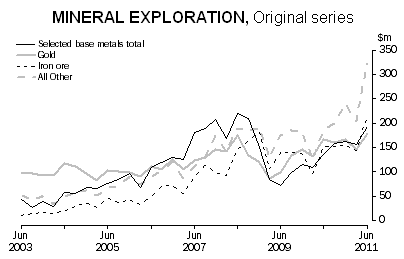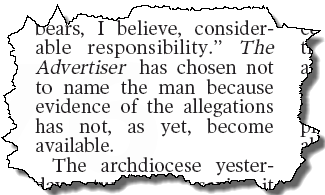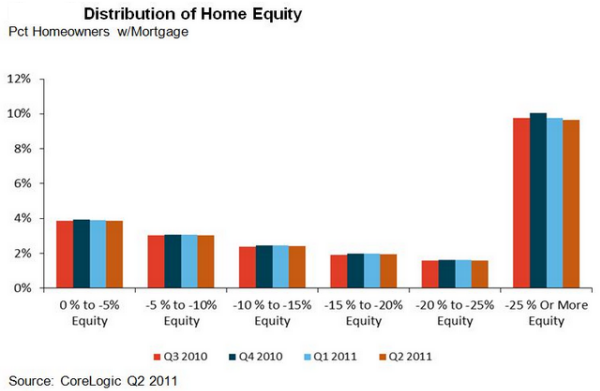Impact of a profits tax on mining. There’s the spin and then there’s the reality. The very talk of a mining profits tax was touted by the Coalition as the reason the mining boom would end. And now along comes the Australian Bureau of Statistics to provide some actual evidence of the impact of the Labor Government’s proposal. The trend estimate for total mineral exploration expenditure rose 8.9% (or $70.1m) to $853.4m in the June quarter 2011.
The current quarter estimate is 43.7% higher than the June quarter 2010 estimate.

In original terms, mineral exploration expenditure rose 39.6% (or $257.3m). Queensland had the largest rise (up 88.1% or $113.7m), followed by Western Australia (up 24.1% or $87.4m).
In original terms, exploration on areas of new deposits rose 35.9% (or $77.1m), while expenditure on areas of existing deposits rose 41.4% (or $180.2m).
In original terms, the largest rise by minerals sought came from expenditure on coal exploration (up 84.9% or $93.1m), with the largest rise occurring in Queensland. The next largest rise came from expenditure on iron ore exploration (up 49.0% or $70.6m).

Naming and shaming. A few thoughts 0n the naming by Senator Nick Xenophon under parliamentary privilege in the Senate last night of allegations that the Brighton, SA, parish priest Monsignor Ian Dempsey has been accused of raping Adelaide-based Anglican Archbishop John Hepworth about 40 years ago.
The view of Nationals Senate leader Barnaby Joyce that using parliamentary privilege circumvented rights and liberties is easy to agree with.
“We’ve got to make sure that everybody has got a certain presumption of innocence until proven otherwise,” Senator Joyce said this morning.
“If you have got the story wrong, then you’ve done an incredible injustice to the person.”
It would just be easier to take him seriously if he got his Coalition colleagues Senator George Brandis and Christopher Pyne to take the same view while we await the investigations by Fair Work Australia and the NSW police into the use by Labor MP Craig Thomson of a credit card paid for by the Hospital Services Union.
The Adelaide Advertiser was a bit previous this morning in the way it treated the story on its front page.

The paper was actually protecting no-one. The man’s name was by this morning well and truly exposed via radio, television and the internet.
From the little snippets of information available about this incident so many years ago it is clearly of a different kind to the mass of stories in recent years about abuse of children by Catholic clergy.
I noticed this morning that the international tribunals at The Hague are now being asked to investigate what United States National Public Radio calls “top Vatican officials over the global clerical sex abuse scandal”, with victims saying these offenses meet the legal definition of crimes against humanity. The Survivors Network of those Abused by Priests, known as SNAP, and the human rights group the Center for Constitutional Rights say the Vatican has yet to implement a policy to crack down on abusive priests and cooperate with law enforcement.
The groups are delivering more than 20,000 pages of documentation from all over the world to the International Criminal Court, or ICC.
Living at home. There are going to be a lot of young adults living at home with mum and dad for a long time if this trend continues much longer. The Australian Bureau of Statistics reports another drop in housing commencements — down 4.7% in the June quarter in sessonally adjusted terms following a rise of 3.3% in the March quarter.

The seasonally adjusted estimate for new private sector house commencements fell 2.1% in the June quarter following a fall of 1.6% in the March quarter.
A housing problem of a different kind. In the United States not only are they building fewer homes than normal but people have having considerable difficulty paying for those there already are.
Figures out overnight that 10.9 million, or 22.5 percent, of all residential properties with a mortgage were in negative equity at the end of the second quarter of 2011, down very slightly from 22.7 percent in the first quarter.

The CoreLogic report said:
An additional 2.4 million borrowers had less than five percent equity, referred to as near-negative equity, in the second quarter. Together, negative equity and near-negative equity mortgages accounted for 27.5 percent of all residential properties with a mortgage nationwide. The new report also shows that nearly three-quarters of homeowners in negative equity situations are also paying higher, above-market interest on their mortgages.







Crikey is committed to hosting lively discussions. Help us keep the conversation useful, interesting and welcoming. We aim to publish comments quickly in the interest of promoting robust conversation, but we’re a small team and we deploy filters to protect against legal risk. Occasionally your comment may be held up while we review, but we’re working as fast as we can to keep the conversation rolling.
The Crikey comment section is members-only content. Please subscribe to leave a comment.
The Crikey comment section is members-only content. Please login to leave a comment.